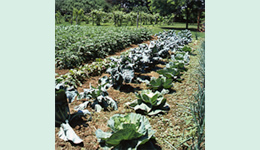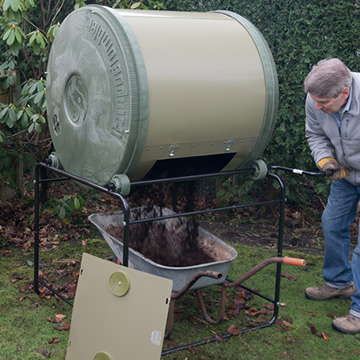How Mantis Composters Work
Thanks to the Mantis ComposTumbler’s unique design, it’s quick and easy to create high-quality fertiliser from your kitchen and garden waste. Our composter models, designed for different household sizes, use the same technology to deliver the best results. Here’s how it works.
Make compost in 3 easy steps with a Mantis ComposTumbler:
Composting Tips
- Be sure the mix of ingredients you put in your tumbler contains wastes high in nitrogen and carbon for a good balance.
- Do not attempt to make compost using any products that have been treated with chemical fertilizers or pest control products.
- If you have bulky items to compost, such as corn cobs, melon rinds, and shrub clippings, be sure to run them through a shredder or chop up the material into smaller pieces before putting them your tumbler. Larger items take longer to break down.
What you can compost
You can add almost any organic material to your compost, and in small quantities you’re unlikely to upset the balance of ‘greens’ and ‘browns’. We give you a free guide to composting with your new Mantis ComposTumbler.
To see a full list of the many items that can be added to your compost, Click here. These are just a few of the things you can turn into quality fertiliser:
- Fresh Grass Clippings
- Shredded Leaves
- Kitchen Trimmings and Peels from Vegetables and Fruits
- Sawdust
- Garden Throwouts such as dead flowers and plants
- Weeds (Yes! The temperature inside the ComposTumbler gets hot enough to kill the weed seeds!)
- Manure from horses, cows, chickens, rabbits, pigs or sheep. (Do not attempt to compost any wastes from dogs or cats.)
- Black-and-white sections of newspapers
- Egg cartons
- Rotted fruits and vegetables
- Pine Needles
- Coffee Grounds
- Tea Leaves or Tea Bags
Benefits of Composting
Healthier soil, better plants and contributing to a natural environment are all key benefits of Composting
- Compost makes hard clay soil more airy so it drains better and provides a healthier base for roots of plants.
- Your own home-made compost is completely safe and natural. It will not harm kids, pets, or the environment.
- Compost builds humus in your soil and improves soil structure, texture, fertility, drainage, and aeration.
- Compost is a mega-boost for plants. They grow bigger, produce bigger yields, and more beautiful flowers.
- Compost makes your plants more resistant to disease.
- Compost bulks-up thin, sandy soil, giving it more substance and texture to support hardy root growth.
- Making compost is a great way to recycle. Instead of sending kitchen and garden wastes to the landfill, turning them into compost recycles them back into nature’s environment as a high-powered natural fertilizer.
- Use compost to top-dress new and existing lawns for thicker, healthier grass. On a newly seeded lawn, spread a thin layer of compost as top dressing. For an existing lawn, aerate first then spread the compost.
A Self-Sustaining Ecosystem
Composting creates a harmonious, natural balance in your garden.
Reduce, Recycle, Return

Healthier Soil!

Bigger, Better Plants!

A Natural Environment

Compost is that wonderful combination of microscopic mineral particles and decomposed organic material that makes your garden thrive. Composting is what gardeners do to control, or assist, the naturally occurring decaying of organic matter.
In the forest, leaves, plants, fruits and nuts, animal waste, and other organic matter decay over time to return to the soil. This process continuously replenishes the soil with the nutrients essential for plant growth. But natural or unassisted organic decomposition is usually relatively slow. Moisture content is inconsistent; the decaying plants, leaves, and animal waste may be relatively large; and the mix of materials in any given area can be somewhat unbalanced.
To make great compost in a relatively short time, you need a good combination of materials, adequate moisture, critical mass, and help from nature (microbes, worms, and other bugs). Turning your composting bin eliminates the problems associated with slow decomposition by:
- Redistributing moisture throughout the mix, since the outside of the mixture dries out quickly, especially in the summer.
- Redistributing the microbe population (and worms, if you have them) to fresh food supplies, where they will digest the organic materials and reproduce.
- Helping to maintain a balance of green and brown materials (assuming you started with, and have maintained, a good mixture).
- Breaking up clumps, so that smaller particles are available for the bugs and worms that turn raw organic matter into compost.
With the unique ComposTumbler design, it’s easy and pain-free to turn your compost.
DO YOU REALLY NEED TO TURN THE COMPOSTING BINS EVERY DAY?
Turning your composting bins every day is ideal, but not absolutely necessary. Composting should be fun, not work. If you miss a day or two, don’t give up. Just get back to turning the composting bins soon. With the right mix of composting materials, adequate moisture, and frequent mixing, you’ll soon have sweet-smelling, wonderfully nutritious, disease-fighting compost working in your garden!
HOW TO SPEED UP THE COMPOSTING PROCESS
STRIVE FOR SMALL PARTICLES
You’ll make better and faster compost if you add small particulate matter to your composting bins. Shredded dry leaves are much better than whole leaves. Coffee grounds are great. Grass clippings should be mixed with leaves, if possible, to prevent clumping. Chop up any stalks from tomato plants or any whole fruits. The little microbes and worms prefer smaller particles, and turning a large batch of small particles is much easier.
MAINTAIN A MOIST MIX
Just like your garden soil, your composting mix needs the right amount of moisture for optimum performance. Not too wet; not too dry. If your mixture is very dry — consisting of a large amount of dry shredded leaves, for example — add a little water. Turn the composting bins to distribute the water throughout the mix, then turn the composting bins so that the ventilation/drainage vents are on the bottom. Excess moisture will leak out of the vents.
Be careful to avoid over-watering; a waterlogged mix will be harder to turn.
BREAK UP LARGE CLUMPS BY HAND
While Mantis composters are easy to turn, and will mix the ingredients quite well, it may be necessary to break up some stubborn clumps by hand. If you’ve added a lot of grass clippings, they may form clumps or mats. Simply reach inside the composter bin to break up and mix any clumps. Using only well-shredded or chopped-up materials should eliminate any need to break clumps by hand, but some gardeners actually like to get a close look at their composting activity.
TURN YOUR COMPOSTING BINS WHENEVER YOU ADD NEW MATERIAL
Remember that whenever you add new material to one of your composting bins, you’re resetting the composting clock to ‘day 1’. If, however, you take several days or even a couple of weeks to fill the first composting bin, just be sure to give the composting bin a few turns every time you add fresh materials.





